|
|
|
Sort Order |
|
|
|
Items / Page
|
|
|
|
|
|
|
| Srl | Item |
| 1 |
ID:
105076
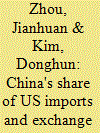

|
|
|
|
|
| Publication |
2011.
|
| Summary/Abstract |
The present paper investigates the effect of China's share of US imports on the aggregate-level exchange rate pass-through to US import prices over the period from January 1999 to December 2008. The paper also focuses on the post-reform period, after 2005, allowing greater flexibility of the RMB to explore the change in the role of the Chinese import share in determining the trend in the US exchange rate pass-through. Evidence reveals that China's share of US imports has a negative effect on the exchange rate pass-through. However, this negative effect has been moderated to a negligible level since China's exchange rate reform. An important implication is that the exchange rate flexibility of the RMB has been raised to a significant level may no longer cause distortion in the US competitive environment and prevent the USA from adjusting current accounts.
|
|
|
|
|
|
|
|
|
|
|
|
|
|
|
|
| 2 |
ID:
122458
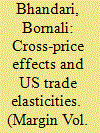

|
|
|
|
|
| Publication |
2013.
|
| Summary/Abstract |
This article examines the interactions of the import and export markets through cross-prices. The idea is that import demand is affected by export prices, because imports and exports are likely substitutes in consumption. Additionally, import supply is also affected by export prices as exports may be intermediate inputs in the production of imports. The traditional partial equilibrium model of trade is extended to include these cross-price effects in demand and supply. Theoretically, it is shown that these cross-price effects can impede trade balance adjustment in the presence of exchange rate and income shocks. Using quarterly US and rest-of-the-world data from 1975 to 2002, a fully modified general method of moments estimation of the structural equations demonstrates significance of cross-price effects in both the demand and supply of non-petroleum merchandise imports.
|
|
|
|
|
|
|
|
|
|
|
|
|
|
|
|
| 3 |
ID:
120623
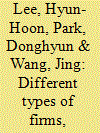

|
|
|
|
|
| Publication |
2013.
|
| Summary/Abstract |
Using highly disaggregated HS 8-digit product-category level data collected by the Chinese Customs Office for 2000 and 2008, we perform an in-depth anatomy of China's imports of manufactured goods. We estimate both the extensive margins - number of products imported per product group or trade partner - and intensive margins - amount of imports per product group or trade partner - of China's imports. Our paper contributes to the literature of firm heterogeneity in international trade in three different ways. First, we distinguish firms into foreign firms and domestic firms, which are further divided into private firms and public firms. Second, we distinguish products into final goods and intermediate goods. Third, we estimate gravity equations from the perspective of dynamics utilizing a dynamic adjustment model. Overall, our analysis yields a number of new stylized facts about China's imports. These, in turn, help us to gain a fuller understanding of China's trade patterns in light of its recent emergence as a globally significant importer.
|
|
|
|
|
|
|
|
|
|
|
|
|
|
|
|
| 4 |
ID:
121192


|
|
|
|
|
| Publication |
2013.
|
| Summary/Abstract |
The article investigates the impacts of imports and foreign capital inflows on economic growth of Pakistan over the period 1990 to 2010. We have applied the structural break autoregressive distributed lag (ARDL) bounds testing approach to cointegration to examine the long-run relationship between the variables. The vector error correction model (VECM) Granger causality multivariate framework is used to investigate the causal relationship between the series. Empirical analysis in this article confirms the long-run relationship between foreign capital inflows, imports and economic growth. The results indicate that foreign capital inflows and imports have positive and significant effect on economic growth in case of Pakistan. Causality analysis reveals the bidirectional causality between the variables, but strong causal relation is running from foreign capital inflows and imports to economic growth.
|
|
|
|
|
|
|
|
|
|
|
|
|
|
|
|
| 5 |
ID:
116507


|
|
|
|
|
| Publication |
2012.
|
| Summary/Abstract |
We estimate that a one-standard-deviation increase in a firm's import penetration ratio raises its likelihood of having engaged in an incremental innovation by 4.48% using a random-sampled firm survey in China. The estimate is close to those in Gorodnichenko, Svejnar and Terrell (2010). A number of empirical strategies rule out alternative explanations as sufficient drivers of our result. Competitive pressure from imports is shown to be an underlying mechanism through which imports spur incremental innovation. We discuss how the link between imports and innovation in the South differ from that in the North.
|
|
|
|
|
|
|
|
|
|
|
|
|
|
|
|
| 6 |
ID:
170172
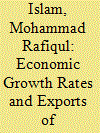

|
|
|
|
|
| Summary/Abstract |
Global images of Bangladesh as a desperately poor country in need of foreign aid require revision in light of recent statistics that confirm impressive economic growth rates despite protracted political problems and climate-related risks. The article presents and discusses statistical evidence relating to recent economic growth rates of Bangladesh in terms of export, import and gross domestic product. This confirms the status of the country as a new tiger economy, moving away from its traditional dependence on agriculture. However, excessive reliance on exports of ready-made garments is found to be risky, while a more balanced growth model with a diverse basket of exports seems advisable.
|
|
|
|
|
|
|
|
|
|
|
|
|
|
|
|
| 7 |
ID:
100965
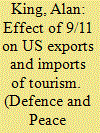

|
|
|
|
|
| Publication |
2010.
|
| Summary/Abstract |
Several studies have investigated whether the terrorist attacks of September 11, 2001, have had an ongoing or merely transitory effect on US trade in tourism. All conclude in favor of the latter. However, limitations in either the data and/or methodology employed by these studies give cause to query their findings. The present study avoids these limitations and finds strong evidence that, once other factors are held constant, real US exports and imports of tourism have both remained significantly below their pre-2001 level.
|
|
|
|
|
|
|
|
|
|
|
|
|
|
|
|
| 8 |
ID:
169904


|
|
|
|
|
| Summary/Abstract |
This paper explores how gasoline prices affect the sales of new and used cars in Lebanon. Using a rich dataset on monthly imported cars from 2000 to 2016, a vector autoregressive analysis is used to model different consumer choices between fuel-efficient cars, midsize cars, and fuel-inefficient cars. We report the first empirical evidence on this question from the Middle East and North Africa (MENA) region using individual automobile data. We use within sample and out-of-sample tests to examine whether gasoline prices influence the sale of fuel-efficient cars. Our results show evidence against the hypothesis that rising gasoline prices shift consumers’ demand toward the most fuel-efficient cars.
|
|
|
|
|
|
|
|
|
|
|
|
|
|
|
|
| 9 |
ID:
112502


|
|
|
|
|
| Publication |
2012.
|
| Summary/Abstract |
There has been considerable concern in Latin America over the implications of increased competition from China for local industry. These concerns include the possibility of "deindustrialization," the increased "primarization" of the region's exports and the difficulties of upgrading manufactured exports into higher technology products. This article examines the impact of Chinese competition both in the domestic market and in export markets on Brazilian industry. It documents the increased penetration of Chinese manufactures in the Brazilian market and the way in which Brazilian exports have lost market share to China in the US, European Union and four Latin American countries. Brazil, because of its more developed and locally integrated industrial sector, is not typical of other Latin American countries and the article also discusses the relevance of the Brazilian experience for the region as a whole.
|
|
|
|
|
|
|
|
|
|
|
|
|
|
|
|
| 10 |
ID:
041114
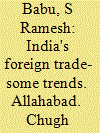

|
|
|
|
|
| Publication |
Allahabad, Chugh Publications, 1988.
|
| Description |
vi, 232p.Hardbound
|
| Standard Number |
8185076464
|
|
|
|
|
|
|
|
|
|
|
|
Copies: C:1/I:0,R:0,Q:0
Circulation
| Accession# | Call# | Current Location | Status | Policy | Location |
| 029008 | 382.0954/BAB 029008 | Main | On Shelf | General | |
|
|
|
|
| 11 |
ID:
126529


|
|
|
|
|
| Publication |
2013.
|
| Summary/Abstract |
This study empirically tests for long-run equilibrium relationship and the direction of causality between imports and energy consumption in Singapore. The results of the present study reveal that a long-run equilibrium relationship exists between import growth and energy consumption growth in Singapore by using bivariate systems. Imports of Singapore converge to long-term equilibrium levels by 79.9 percent speed of adjustment through the channel of energy growth. Furthermore, the major finding of this study is that there are long- and short-term undirectional causalities that run from energy growth to import growth in Singapore, which denote that energy consumption in Singapore is a catalyst for importing.
|
|
|
|
|
|
|
|
|
|
|
|
|
|
|
|
| 12 |
ID:
166573
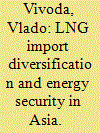

|
|
|
|
|
| Summary/Abstract |
Asia's share of global demand for natural gas has increased from 12 to 21 per cent since the turn of the century, and the overall consumption has more than doubled. At the same time, there is a widening gap between regional natural gas demand and supply, with increasing reliance on imports. In 2017, Asian importers absorbed 72 per cent of globally traded liquefied natural gas (LNG). Their LNG import dependence is forecast to grow significantly over the coming decades. This paper explores major Asian importers' approaches to LNG import diversification between 2001 and 2017 and explains why patterns of LNG imports differ across countries and over time. The focus of the paper is on five largest LNG importers in the region: China, India, Japan, South Korea and Taiwan. The paper utilises the Herfindahl-Hirschmann index (HHI) of market concentration to evaluate LNG import diversification across the five countries. The analysis contributes to a growing body of literature that evaluates various aspects of energy import diversification in the context of broader energy security strategies. Findings suggest that all countries have improved their LNG import portfolios, although there is significant temporal variation across countries. Reflecting on the relationship between energy security and growth, the paper concludes by outlining policy implications for regional energy policymakers.
|
|
|
|
|
|
|
|
|
|
|
|
|
|
|
|
| 13 |
ID:
157618


|
|
|
|
|
| Summary/Abstract |
This paper seeks to review India’s external trade since 2000-01. It highlights the positive features reflected in trade trends. It also tries to flag certain areas of concern that may need to be addressed. It attempts to present an overall snapshot and some macro perspectives rather than getting into a detailed analysis product wise or market wise. The essay also dwells briefly on the current framework of rules governing international trade, particularly as they relate to India.
|
|
|
|
|
|
|
|
|
|
|
|
|
|
|
|
| 14 |
ID:
140588


|
|
|
|
|
| Summary/Abstract |
INTERNATIONAL TRADE has been marked by dramatic dynamics in the years after the global financial crisis of 2008-2009. The 23% plunge in global exports - in monetary terms - was followed by a nearly "mirror-like" increase in 2010 and 2011, by 22% and 20% respectively. However, in 2012, international trade stagnated, showing effectively zero growth, and 2013 saw a mere 2% increase.
|
|
|
|
|
|
|
|
|
|
|
|
|
|
|
|
| 15 |
ID:
163564


|
|
|
|
|
| Summary/Abstract |
n 1900 a Swedish member of parliament argued that Sweden had a Damocles Sword hanging over it due to the country's rapidly growing imports of coal. This energy import dependence has continued to plague Sweden ever since. While coal dominated imports in the first half of the twentieth century, oil and uranium dominated in the second half. This article examines how Swedish public and private actors coped with the country's energy dependence. Several crises prompted such efforts. Coal strikes in the Interwar years and oil embargoes in the 1970s spurred diversification and collaboration with other importing countries. During World War II Sweden built trustful coal relations with Nazi Germany and stockpiled coal. In the post-war era fear of the international oil majors spurred attempts to increase public control over energy imports, and a state-owned company for foreign oil exploration was set up. Moreover, during and after wars and other acute crises Swedish actors intensified their efforts to exploit more of the country's domestic energy resources. However, when the crisis was over it often proved to be cheaper to import energy from abroad. Thus imports have remained high and the Damocles Sword is still hanging over Sweden.
|
|
|
|
|
|
|
|
|
|
|
|
|
|
|
|
|
|
|
|
|